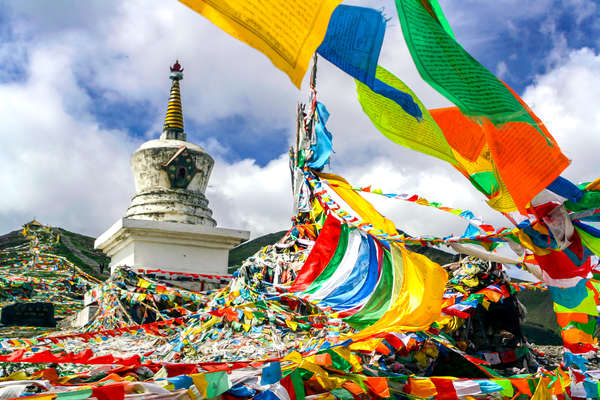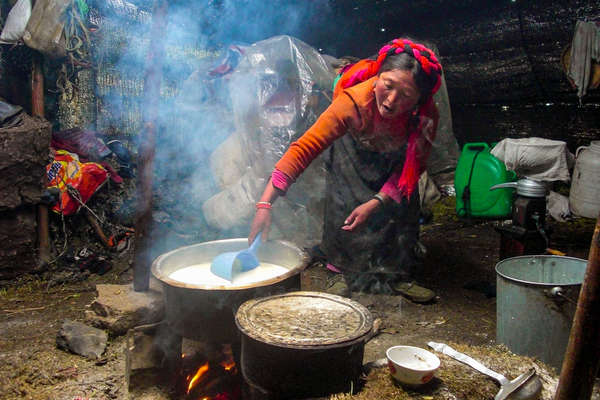Comfort
You will stay in a variety of accommodation. On some nights you will be camping in two-man tents (mattresses provided but you must bring own sleeping bag). On other nights you might be staying in a monastery, a mountain retreat or a guesthouse. During the ride and when camping, you will have access to different types of washing facillities - bathrooms with running water or rivers for both washing and laundry. You should ride knowing that you will be exploring some very remote parts of the country and that the accommodation will be basic.
In Chengdu, you will be staying in a local hotel.
Meals
The meals are predominently Chinese and Tibetan. The base is rice, accompanied by vegetable and meat dishes - with some spices and hot peppers. Meals are essentially savoury and there is no dessert, so we recommend that sweet lovers bring their own supply of biscuits!
During the trail:
Breakfast: coffee, tea, powdered milk, bread, jam, eggs or Chinese food (noodles, fried rice etc)
Lunch: Light picnic (bread, sausage, yoghurt)
Dinner: Rice, vegetables, meat - fragrant Chinese and Tibetan cuisine
In towns and villages you will eat in local restaurants.
Water:
Take care not to drink water from unknown sources. Mineral water is provided at every meal whilst on the trail, or you can refill your bottles using boiled water (or bring water purification tablets). In restaurants it might be possible to get beer or fizzy drinks.
Climate
Rides are run during the summer season (June to September) when daytime temperatures are warm but the evenings and mornings can be cold. July and August are the hottest months with minimum and maximum temperatures of 22 and 30c in Chengdu. Temperatures at altitude can be much cooler and the mountains are the perfect place to escape the summer heat.
Tips
If you are happy with the service that you receive from the local team then you may wish to leave a tip. To remain consistent with the standard of living in China we recommend a tip of c. £50 per rider which can be distributed amongst all of the staff.
Packing list
Please pack in accordance with local religious and traditional cultures - it is important to keep your shoulders and knees covered when meeting the local people. Please do not wear shorts or strappy tops in towns and villages.
The maximum weight limit on this ride is 17kg per person due to the fact that we are using pack animals. We recommend packing in waterproof packing cubes or duffel bags.
Head
- Equus Journeys strongly recommend that you wear a riding helmet and that you take your own to ensure a correct fit. There are many lightweight options available nowadays
- Sunhat for when not riding
- Sunglasses - with a cord attached so they don't fly off when riding
- Buff or bandana
- Warm hat for cold nights when camping
Upper body
- Thermals (long or short sleeved)
- Long sleeved shirts provide protection from the sun and are an extra layer
- T-shirts
- Lightweight fleece or jumper
- Warm fleece or jumper (and a spare in case one gets wet)
- Warm and waterproof jacket - it can rain at any time of year and the evenings can be particularly cold
Legs
- Lightweight, comfortable riding trousers or jodhpurs - we recommend riding in them at home before taking them on holiday to ensure they don't rub
- Thermals
- Casual trousers for the evenings, such as jeans or tracksuit bottoms
- Waterproof over trousers
- Lightweight, comfortable trousers for non-riding days
Hands and Feet
- Comfortable riding boots. We recommend short boots with half chaps but you may wish to take long chaps as an extra layer against inclement weather. We don't recommend taking your favourite long leather boots in case they get damaged
- Waterproof shoes/boots can be useful for abundant dew in the mornings or when it rains
- Trainers or equivalent light shoes for moving around the camp in the evenings
- Several pairs of warm, thick socks
- Gloves - your hands are particularly exposed to the sun, cold or rain whilst riding. Waterproof gloves can be particularly useful
Nightwear
- Sleeping bag. You need at least a comfort factor down to minus 5 celsius, but would recommend at least minus 8 or 10 celsius.
- Sleeping bag liner - silk, cotton or fleece - adds an extra layer.
- Self-inflating mattress such as a Thermarest. (a thin pad is provided but an additional layer may be welcome)
- Pyjamas or tracksuits or thermals for sleeping in
Other useful items
- Swimsuit - for swimming/bathing in rivers
- Towels - lightweight camping ones will both dry and pack more easily
- Small backpack for accessing items required during the day (carried by support crew)
- Camera and high capacity memory card. Spare battery
- Bumbag for carrying your camera and small items whilst riding
- Headtorch or small torch for moving around camp at night - bring spare batteries and bulbs
- Water bottle (2 litres or 2 x 1 litre)
- Wet Wipes or equivalent (for when washing facilities aren't available)
- Toilet paper and a lighter to burn it with
- Small plastic bags for rubbish
- Ear plugs (for light sleepers)
In your hold luggage
- Any liquids, such as shampoo, moisturiser, deodorant unless they are less than 100ml and all bottles can fit in a small, clear, plastic ziplock bag. We recommend biodegradable washing products where possible.
- Swiss army knife (or equivalent)
In your hand luggage
- Any valuables, such as your camera, ipod, ipad etc.
- Your riding hat
Medical kit
- Sunscreen and lip balm - should be high factor
- Insect repellent, preferably containing deet
- Any medication you regularly take
- Blister plasters in case of any rubs
- Antiseptic cream, plasters, aspirin, anti-histamine, insect-bite salve etc...
- Spare prescription glasses/contact lenses
- Eye drops
- Imodium or similar anti-diarrhoea medication
- Re-hydration sachets
- Water purification tablets
- Antiseptic wipes
- Handwash gel
Our Recommendations
- Please don't take a hard sided suitcase. Your luggage should be soft sided with a capacity of 60-80 litres. We recommend taking a backpack or similar. The luggage limit on the ride is 15kg per person.
- Backpacks cannot be worn whilst riding. We recommend a small bumbag or a coat with pockets so that you can carry small items with you during the day (camera, sunscreen, lipbalm etc)
- We recommend travelling in your riding boots and carrying your hat and some riding clothes in your hand luggage - then if your luggage goes astray you are still able to ride!
- Tall riders may benefit from taking a pair of long stirrup leathers with them (the local stirrups are adjustable but are sometimes limited in length)
- We recommend taking a copy of your passport and insurance documents with you in case you lose your originals
- Please take your rubbish home with you. There are no recycling facilities in Tibet, so take your used batteries, aerosols etc back home and dispose of them appropriately. Try to leave excess packaging material at home before travelling












